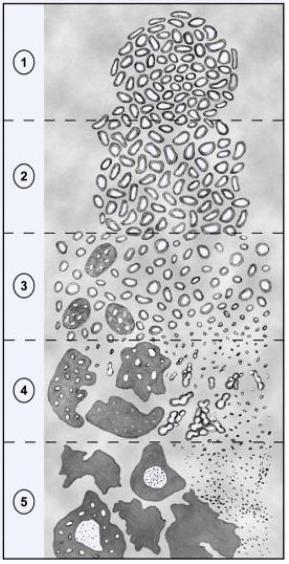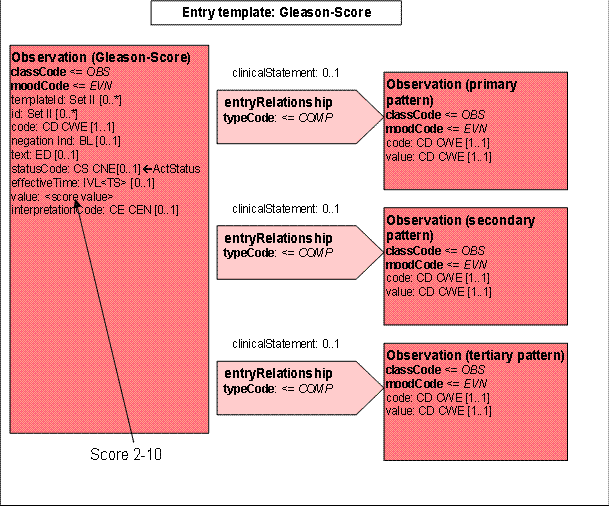Gleason-Score-Entry (Template)
Slang (Diskussion | Beiträge) (→Attribute) |
Slang (Diskussion | Beiträge) (→Attribute) |
||
| Zeile 161: | Zeile 161: | ||
|1..1 | |1..1 | ||
|required | |required | ||
| − | | | + | | |
| + | Value Set: [[#Gleason-Score|todo.valueset.gleason002]] | ||
|- | |- | ||
Version vom 2. Oktober 2013, 12:57 Uhr
Dieses Material ist Teil des Leitfadens Arztbrief 2.x.
|
Inhaltsverzeichnis
Entry: Gleason-Score
| Template-Metadaten | |
| Template-Typ | Entry |
| Template ID | 1.2.276.0.76.3.1.131.1.10.3.9 |
| generischeres Template | Assessment Scales |
| genutztes Template | |
| abgeleitete Templates | |
| Generelle Beschreibung | Gleason-Score (Prostatakarzinom) |
| allg. Erläuterung | |
| Ballotierungsstatus | in Arbeit |
| Erweiterbarkeit | geschlossen |
Der Gleason-Score dient zur Malignitätsbeurteilung des Prostatakarzinoms. Der Gesamtscore wird dabei aus der Addition zweier einzelner Beurteilungen (primäres und sekundäres Gleason-Muster) in einem komplizierten Verfahren der semiquantitativen Bewertung von
- Entdifferenzierungsgrad
- Wachstumsmuster
gebildet. Es gibt die primären Gleason-Muster 1-5 (aufsteigende Malignität).
Der Gleason Score setzt sich beim Resektionspräparat aus der Summe des häufigsten und des zweithäufigsten, bei der Stanzbiopsie des schlechtesten und des zweitschlechtesten Gleason-Musters zusammen. Ist nur ein Muster erkennbar (häufig in Stanzbiopsien), so wird der Score aus dem verdoppelten Musterwert gebildet. An der Stanze sind Gleason-Muster <3 nicht zugelassen.
Damit ergeben sich Gesamtwerte von 2 bis 10 (s. hierzu auch Scores & Assessment DSTU). Seit 2005 gilt die leicht modifizierte Gleason-Klassifizierung (nach Epstein \[Helpap2007\]), d.h. es ist hier die Angabe des verwendeten Verfahrens – genauer die zu verwendenden Codes - erforderlich.
In Resektionspräparaten kann ein drittes (höheres) Muster notiert werden, wenn es mehr als 10% des Tumors betrifft. Der Gleason Score wird in seiner Ausprägung (Addition zweier Werte)davon jedoch nicht beinflusst. Die Gesamtdarstellung könnte lauten: "Gleason-Score 3+4=7, tertiäres Muster 5".
Modell
Attribute
| Lvl | RIM | Name | DT | Kard | Conf | Beschreibung |
|---|---|---|---|---|---|---|
| 3 | act | observation | 1..1 | M | fix: @classCode="OBS" @moodCode= "EVN" | |
| 4 | act | templateId | II | 1..1 | required | Gleason-Score @root="1.2.276.0.76.3.1.131.1.10.3.9" |
| 4 | act | id | II | 0..1 | optional | ID der diagnostischen Angabe @root=OID des sendenden System, um diagnostische Angaben eindeutig zu identifizieren |
| 4 | act | code | CD CWE | 1..1 | F | @code="35266-6" @codeSystem=LOINC: "2.16.840.1.113883.6.1" |
| 4 | act | text | ED | 1..1 | required | textliche Beschreibung des codierten Inhalts der Observation; wird i.d.R. vom sendenden System automatisch generiert |
| 4 | act | effectiveTime | TS | 0..1 | O | Das Datum, an dem die Diagnose gestellt wurde |
| 4 | act | value | CD | 1..1 | required | Gleason-Score Value Set: todo.valueset.gleason001 |
| 5 | act | entryRelationship | 0..1 | O | @typeCode="COMP" | |
| 6 | act | observation | 1..1 | M | Gleason 1 (primäres Gleason-Muster, Entdifferenzierungsgrad) | |
| 7 | act | code | 1..1 | F | @code=LOINC: "44641-9"
@codeSystem=LOINC: "2.16.840.1.113883.6.1" | |
| 6 | act | value | CV | 1..1 | required |
Value Set: todo.valueset.gleason002 |
| 7 | act | @code | 1..1 | F | eigentlicher Code: Codesystem 1.2.276.0.76.5.402 | |
| 7 | act | @codeSystem | 1..1 | F | fix: "1.2.276.0.76.5.402" | |
| 5 | act | entryRelationship | 0..1 | optional | @typeCode="COMP" | |
| 6 | act | observation | 1..1 | M | Gleason 2 (sekundäres Gleason-Muster, Entdifferenzierungsgrad) | |
| 6 | act | code | CV | 1..1 | F | @code=LOINC: "44642-7" @codeSystem=LOINC: "2.16.840.1.113883.6.1" |
| 6 | act | value | CV | 1..1 | required | Code für das sekundäre Gleason-Muster |
| 7 | act | @code | 1..1 | required | eigentlicher Code: Codesystem 1.2.276.0.76.5.403 | |
| 7 | act | @codeSystem | 1..1 | F | fix: "1.2.276.0.76.5.403" | |
| 5 | act | entryRelationship | 0..1 | optional | @typeCode="COMP" | |
| 6 | act | observation | 1..1 | M | Gleason 3 (tertiäres Gleason-Muster, Entdifferenzierungsgrad) | |
| 6 | act | code | CV | 1..1 | required | @code= LOINC: "44643-5" @codeSystem=LOINC: "2.16.840.1.113883.6.1" |
| 6 | act | value | CV | 1..1 | required | Code für das tertiäre Gleason-Muster |
| 7 | act | @code | 1..1 | required | eigentlicher Code: Codesystem 1.2.276.0.76.5.40? | |
| 7 | act | @codeSystem | 1..1 | F | fix: "1.2.276.0.76.5.40?" |
Beispiel
<observation classCode="OBS" moodCode="EVN">
<templateId root="1.2.276.0.76.3.1.131.1.10.3.9"/>
<id extension="1234009"
root="1.2.276.0.76.3.1.131.1.4.3.9999.9999.999919"/>
<code code="35266-6"
codeSystem="2.16.840.1.113883.6.1"/>
<text>
Gleason-Score: 4+5=9
</text>
<effectiveTime value="20110326"/>
<value xsi:type="CD" code="9" codeSystem="1.2.276.0.76.5.404">
</value>
<!-- Einzelwerte zum Score: 1. Wert -->
<entryRelationship typeCode='COMP' inversionInd='false'>
<observation moodCode='EVN' classCode='OBS'>
<code code='44641-9' displayName=''
codeSystem='2.16.840.1.113883.6.1' codeSystemName='LOINC' />
<statusCode code='completed'/>
<value xsi:type='CD' code='4' codeSystem='1.2.276.0.76.5.402'/>
</value>
</observation>
</entryRelationship>
<!-- Einzelwerte zum Score: 2. Wert -->
<entryRelationship typeCode='COMP' inversionInd='false'>
<observation moodCode='EVN' classCode='OBS'>
<code code='44642-7' displayName=''
codeSystem='2.16.840.1.113883.6.1' codeSystemName='LOINC' />
<statusCode code='completed'/>
<value xsi:type='CD' code='5' codeSystem='1.2.276.0.76.5.403'/>
</value>
</observation>
</entryRelationship>
</observation>
Vokabular
Gleason Score
Value Set OID todo.valueset.gleason001
Code System OID 1.2.276.0.76.5.404
Ergänzend zur Codierung ist auch die Zuordnung zum Grading (Malignitätsgrad) hier aufgeführt.
| Code | Bedeutung | Malignitätsgrad | Bedeutung |
|---|---|---|---|
| 2 | Gleason-Score 2 | G1 | gute Prognose |
| 3 | Gleason-Score 3 | G1 | gute Prognose |
| 4 | Gleason-Score 4 | G1 | gute Prognose |
| 5 | Gleason-Score 5 | G2 | gute Prognose |
| 6 | Gleason-Score 6 | G2 | gute Prognose |
| 7 | Gleason-Score 7 | G2-G3 | gute / schlechte Prognose |
| 7a | Gleason-Score 7a (ergibt sich aus 3+4) | G2 | gute Prognose |
| 7b | Gleason-Score 7b (ergibt sich aus 4+3) | G3 | schlechte Prognose |
| 8 | Gleason-Score 8 | G3 | schlechte Prognose |
| 9 | Gleason-Score 9 | G3 | schlechte Prognose |
| 10 | Gleason-Score 10 | G3 | schlechte Prognose |
Entdifferenzierungsgrad
| Code | Description | Bedeutung |
|---|---|---|
| 1 | Round to oval equal individual glands, lying close to each other, sharply demarcated from the surrounding area | Runde bis ovale gleich große Einzeldrüsen, dicht nebeneinander liegend, scharf gegen die Umgebung abgegrenzt |
| 2 | Slightly less uniform single glands, separated by small amounts of stroma, less sharply defined tumor margin | Etwas weniger uniforme Einzeldrüsen, getrennt durch geringe Mengen von Stroma, weniger scharf begrenzter Tumorrand |
| 3 | a) Irregularly large and irregularly shaped glands, usually with abundant stroma, sometimes also stored tightly irregular and indistinct tumor border | Unregelmäßig große und unregelmäßig gestaltete Drüsen mit gewöhnlich reichlicherem Stroma, gelegentlich auch dicht gelagert, unregelmäßige und unscharfe Tumorgrenze |
| b) Papillary or cribriform structures, sometimes in large gang-like formations |
Papilläre oder kribriforme Strukturen, z.T. in großen gangähnlichen Bildungen | |
| 4 | a) Large irregular Epithelformationen by glandular fusion ("fused glands") and branched glands with irregular infiltration into the surrounding area | Große unregelmäßige Epithelformationen durch Drüsenverschmelzung („fused glands") sowie verzweigte Drüsen mit unregelmäßiger Infiltration in die Umgebung |
| b) Adenocarcinoma with prominent clear cytoplasm similar to clear cell adenocarcinomas of the kidney | Adenokarzinom mit ausgeprägt klarem Zytoplasma ähnlich hellzelligen Adenokarzinomen der Niere | |
| 5 | a) Circumscribed round epithelial clusters with mostly solid and cribriform construction, usually with central necrosis (comedo carcinoma-like) | Scharf begrenzte runde Epithelhaufen mit meist solidem und kribriformem Bau, gewöhnlich mit zentraler Nekrose
(komedo-karzinomähnlich) |
| b) Irregularly shaped formations of an undifferentiated carcinoma, which only just discernible glandular formation or is identified vacuoles (signet ring-like) than adenocarcinoma | Unregelmäßig begrenzte Formationen eines undifferenzierten Karzinoms, das nur durch gerade noch erkennbare Drüsenbildung
oder Vakuolen (siegelringähnlich) als Adenokarzinom zu identifizieren ist |
Tabelle 31: Entdifferenzierungsgrad nach Gleason-Score17 (OID 1.2.276.0.76.5.402)

